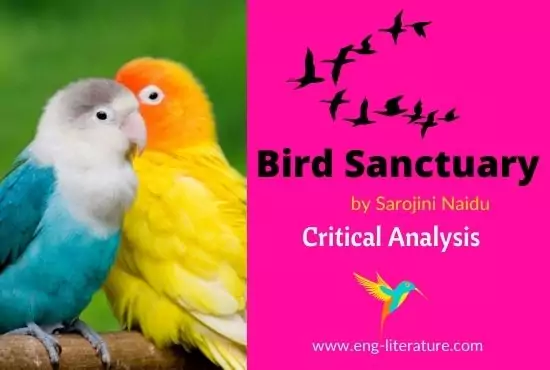The Bird Sanctuary by Sarojini Naidu Analysis
The Bird Sanctuary by Sarojini Naidu Introduction
Sarojini Naidu is the Nightingale of India, Bharat Kokila. She is a lyricist and as such her work is marked by a delicate fancy and haunting music. She has exhibited high workmanship and material dexterity in the composition of her poems which are remarkable for their cadences that are mellifluous. Her poems are ‘golden cadences’ in ‘silken terms’ dealing in scintillating and dazzling images. She mainly deals in her poetry with the themes of love, nature and the Indian pageant. Her poetry seems to sing itself as if her swift thoughts and strong emotions sprang into lyrics of themselves. Her poems seem to breathe the fragrance of spring and ring with the music of the song of various birds. However her poems are poignant and noble. She is a sensitive poet in whom the Bengali and the Deccani voices mingle and merge. Her poems reflect her preoccupation with the dream world and the Indian folk-life.
“The Bird Sanctuary” extracted form her poems entitled The Feather of the Dawn was inspired by her visit to the bird sanctuary in Bombay. This is one of the finest poems written by Sarojini Naidu. This speaks of Sarojini’s potential as a poet. The whole poem is one long extended metaphor. Sanctuary is a place which provides shelter to those who are in search of it. Here it refers to a place of shelter for birds. The bird sanctuary, visualized here, gives joy and fostering freedom, nesting place and singing space to everything that has feathers. It is a gracious garden for birds in Search of a comfortable and happy home.
Here Sarojini Naidu depicts God as the ‘Master of Birds’ and his creation (this world), as the bird sanctuary. When it is dawn, there is a tumult in the bird sanctuary. The birds (winged choristers) Sing carols in richly condensed ecstasy celebrating the ‘festival of dawn.’ The rich variety of birds with their diversity of colour is symbolic of mankind, marked by a great number of religions, nationalities, castes, creeds and so on. From their throats of amber ebony and faun colours raise pleasant lyrics in praise of dawn. The bulbul, the oriole, the honey-bird and shema, the gull, the hoopoe, and the kingfisher, all of them lushed with the pride of their glory, exhibit as if they are taking part in a carnival of joy and springtide. The gray pigeons and the parrots also do not lag behind in celebrating the festivities which they have decided to celebrate with pride and magnificence.
In the last stanza she prays to God the ‘Master of the Birds’ to give her sanctuary and shelter in His gracious garden which is full of joy and fostering freedom, because she has some frustrating experience in life which has delivered a rude shock (having bird that bears a broken wing). She seeks comfort and solace in the presence of the Lord. The poet wishes that the human spirit is in equal need of a sanctuary amidst a violent, uncertain and harsh world.
Also Read:
The master of the birds, who has provided this pleasant sanctuary is implored to provide shelter to a homing bird as to others, that has a broken or bruised wing. Here the poetess strikes an autobiographical note. Her poetic wings are bruised and broken, her earlier flush of poetic inspiration seems to be forsaking her, and she will not be able to compose any more poetry. Politics seems to be dampening her poetic spirit. At this time she needs a sanctuary like the one provided to the birds by the Master of the birds, where they have joy, peace and gaiety all around.
The poem has four stanzas of four lines each. The last stanza is the essence, as it were of what has been stated in the first three stanzas. In the morning the birds rouse from their slumber and sing sweet musical and joyous songs in well-measured cadences. The festival of dawn is celebrated by all the birds who sing joyous songs to greet it. The birds are of variegated types, and they swell their throats in all their splendour to sing songs of gaiety to the dawn early in the morning. From the branches of the trees in which the birds fly to and fro, drip the drops of dew and nectar. The colour of the sea-birds is white like silver and it has become more white as it has been continuously washed by the white water and foam of the sea.

Hello, Viewers! Besides being the Founder and Owner of this website, I am a Government Officer. As a hardcore literary lover, I am pursuing my dream by writing notes and articles related to Literature. Drop me a line anytime, whether it’s about any queries or demands or just to share your well-being. I’d love to hear from you. Thanks for stopping by!

Awesome work is really helpful for students hope you continue your work and your nurture your love for literature.
Convey my thanks